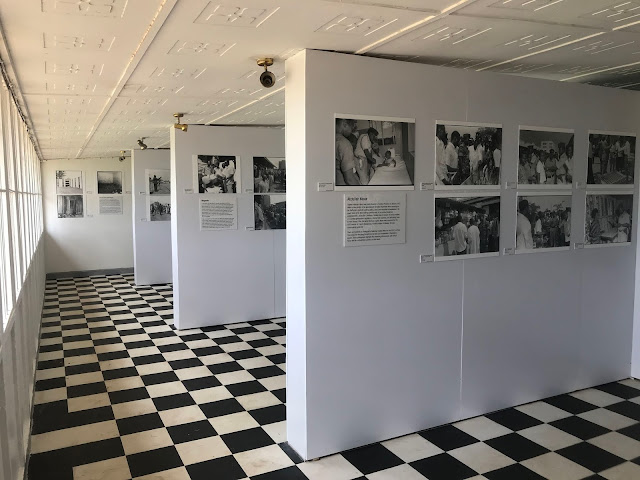Thursday Sept. 12, 2019 was the first penny Stamps lecture of the Fall term. Speaking were the founding members of the Cyborg Foundation: Moon Ribas and Neil Harbisson.
Unfortunately, Neil was unable to get a visa to come to Ann Arbor. But that's where I came in.
Chrisstina Hamilton contacted me in the last week of August to ask if I could help them arrange a way top present Neil remotely in a fully professional way. I worked with Andre Grewe of Stamps to put it all together.
I brought our DMC streaming kit to the mix which allowed me to use the Presentation laptop from the stage and the Video Conferencing laptop backstage as inputs to Wirecast. I was then able to switch between them, and even make a Picture-in-Picture output combining Neil and his presentation images. And the output of my computer was then sent to the video crew that was capturing the event and to the Michigan Theater projection system.
 |
| My setup backstage: VC on the left, Wirecast on the right. |
 |
| PIP as seen on Wirecast screen. |
I also used our camera to feed a view of the stage back to Neil. it was getting audio from the house mix so the stave mics and audio from the presentations could be heard clearly in Switzerland.
 |
| Moon and Adam during setup. You can't see it, but the VC camera is off to the left. |
The BlueJeans video conference was all done over the Michigan Theater's wifi network, and it all worked almost flawlessly. There was an occasional glitch in the VC image, but Neil's voice never dropped out. We were prepared to "throw an ethernet cable" over to Lane Hall if needed, but we were good.
For about the past decade, Moon and Neil have been putting sensors of various sorts into their bodies in order to become Cyborgs. For example, Moon seems to be very interested in earthquakes. Among other things, she had sensors surgically implanted into her feet that would vibrate any time there was an earthquake anywhere on the planet.
She also had an interesting story about how she and Neil had a prosthetic tooth put into a gap they each had in their mouth. They could send a click to each other by pressing on it with their teeth. This photo shows them on a table with their backs to each other communicating by morse code. And the teeth used Bluetooth to communicate: it was a Bluetooth tooth...
 |
| The Bluetooth tooth demo. |
 |
| Installation of Moon's earthquake sensors. |
Neil has an antenna surgically attached to the back of his head. It curves up over his forehead. He is color blind and he uses this antenna to sense different colors and then produce a musical note. So when he hears a G he knows the color is yellow, etc.
 |
| Neil's antenna seen from the Wirecast screen. |
And it took some doing, but Neil actually has his UK passport photo showing him with his antenna.
Their talk started with a bass drum piece whose score was written by the number and intensity of earthquakes around the world from 1976 to 2019. Each year got 10 seconds.
Moon gave her presentation while Neil was watching via BJ.
Of course, he could not resist taking a few photos with his phone - but I was the only one that saw it since he was not yet "live".
Then she introduced Neil and she ran his presentation locally while he spoke from Switzerland.
The best part, though, was when their colleague Adam came out with *his* antenna, and he and Neil connected them across the Atlantic to share information. Adam first pointed his antenna to a variety of colored objects and then Neil would tell us what color they were. This was all the more impressive because Moon forgot to move the camera so Neil could see at which object Adam was pointing his antenna.
And the Grand Finale was when Adam went out into the audience and "read" the faces of some people. Neil then recorded what he was hearing from his antenna and played the notes back to us. A fine time was had by all.
That's it for now - and until next time, have a good time!

















































